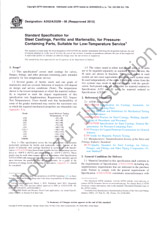Wir benötigen Ihre Einwilligung zur Verwendung der einzelnen Daten, damit Sie unter anderem Informationen zu Ihren Interessen einsehen können. Klicken Sie auf "OK", um Ihre Zustimmung zu erteilen.
ASTM E3294-22
Standard Guide for Forensic Analysis of Geological Materials by Powder X-Ray Diffraction
Name übersetzen
NORM herausgegeben am 15.3.2022
Informationen über die Norm:
Bezeichnung normen: ASTM E3294-22
Anmerkung: UNGÜLTIG
Ausgabedatum normen: 15.3.2022
SKU: NS-1064850
Zahl der Seiten: 15
Gewicht ca.: 45 g (0.10 Pfund)
Land: Amerikanische technische Norm
Kategorie: Technische Normen ASTM
Die Annotation des Normtextes ASTM E3294-22 :
Keywords:
cement, concrete, forensic, geology, soils minerals, X-Ray diffraction,, ICS Number Code 07.140 (Forensic science),71.040.50 (Physicochemical methods of analysis),91.100.15 (Mineral materials and products)
Ergänzende Informationen
| Significance and Use |
|
5.1?The overarching goals of the forensic analysis of geological materials include (5.2?Within the analytical scheme of geological materials, XRD analysis is used to: identify the crystalline components within a sample; identify the crystalline components separated from a mixture, typically clay-sized material (see 8.8), or a selected particle class for which additional analysis is needed (see 8.11); or compare two or more samples based on the identified crystalline phases or diffraction patterns (see 11.5). 5.2.1?Non-destructive XRD analysis can be performed in situ on geological material adhering to a substrate (see 8.12.3). 5.2.2?The most common forensic applications of XRD to geological materials are (A) identification or confirmation of a selected phase or fraction of a sample (see 8.12), (B) identification of minerals in the clay-sized fractions of soils (see 8.8), and (C) identification of the phases of the hydrated cement component of concrete or mortar. 5.3?This guide is intended to be used with other methods of analysis (for example, polarized light microscopy, scanning electron microscopy, palynology) within a more comprehensive analytical scheme for the forensic analysis or comparison of geological materials. 5.3.1?Comprehensive criteria for forensic comparisons of geological material integrating multiple analytical methods and provenance estimations (see 11.4) are not included and are beyond the scope of this guide. |
| 1. Scope |
|
1.1?This guide covers techniques and procedures for the use of powder X-ray diffraction (XRD) in the forensic analysis of geological materials (to include soils, rocks, sediments, and materials derived from them such as concrete), to enable non-consumptive identification of solid crystalline materials present as single components or multi-component mixtures. 1.2?This guide makes recommendations for the preparation of geological materials for powder XRD analysis with adaptations for samples of limited quantity, instrumental configuration to generate high-quality XRD data, identification of crystalline materials by comparison to published diffraction data, and forensic comparison of XRD patterns from two or more samples of geological materials to support criminal investigations. 1.3?UnitsThe values stated in SI units are to be regarded as standard. Other units are avoided, in general, but there is a long-standing tradition of expressing X-ray wavelengths and lattice spacing in units of ?ngstr?ms (?). One ?ngstr?m = 1010 meter (m) = 0.1 nanometer (nm). 1.4?This standard is intended for use by competent forensic science practitioners with the requisite formal education, discipline-specific training (see Practice E2917), and demonstrated proficiency to perform forensic casework. 1.5?This standard does not purport to address all of the safety concerns, if any, associated with its use. It is the responsibility of the user of this standard to establish appropriate safety, health, and environmental practices and determine the applicability of regulatory limitations prior to use. 1.6?This international standard was developed in accordance with internationally recognized principles on standardization established in the Decision on Principles for the Development of International Standards, Guides and Recommendations issued by the World Trade Organization Technical Barriers to Trade (TBT) Committee. |
Empfehlungen:
Aktualisierung der technischen Normen
Wollen Sie sich sicher sein, dass Sie nur die gültigen technischen Normen verwenden?
Wir bieten Ihnen eine Lösung, die Ihnen eine Monatsübersicht über die Aktualität der von Ihnen angewandten Normen sicher stellt.
Brauchen Sie mehr Informationen? Sehen Sie sich diese Seite an.




 Cookies
Cookies
